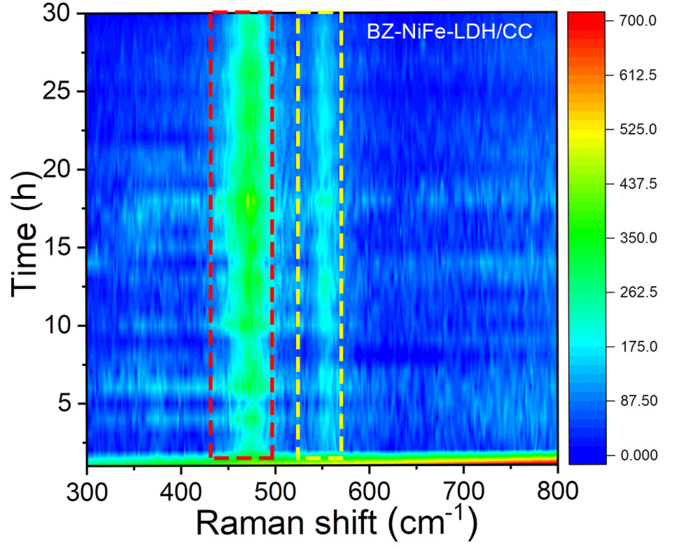Reviewed by Mila PereraSep 22 2022
The ideal stock feed for sustainable fuel could be seawater as it is plentiful, renewable, and economical. It also comprises precisely the correct ingredients to create superior quality hydrogen.
 Spectroscopy imaging demonstrates the phase transition of OH- into oxygen through the newly developed electrode material of benzoate-nickel-iron-layered double hydrides on carbon cloth (BZ-NiFe-LDH/CC). Image Credit: Nano Research Energy
Spectroscopy imaging demonstrates the phase transition of OH- into oxygen through the newly developed electrode material of benzoate-nickel-iron-layered double hydrides on carbon cloth (BZ-NiFe-LDH/CC). Image Credit: Nano Research Energy
The disadvantage is that it comprises less-preferred elements, such as chlorine, obstructing conversion technology. An international team of researchers may have created a substitute processing system that acquires all the advantages without the chlorine-caused issues of earlier attempts.
They reported their results in the September 6th, 2022 issue of Nano Research Energy.
“Seawater electrolysis is an extremely attractive approach for harvesting clean hydrogen energy, but detrimental chlorines species, such as chloride or hypochlorite, cause severe corrosion at the anode,” said the study’s corresponding author Xuping Sun, Professor at the University of Electronic Science and Technology of China and the Shandong Normal University.
Electrolysis is the process of applying an electric charge to water and separating its constituents, creating oxygen and hydrogen. Hydrogen can be a clean fuel that only releases water as it burns, rather than the destructive carbon dioxide emitted by fossil fuels.
The cathode, or negative electrode, draws the OH− and helps them decrease into the preferred molecules of two hydrogen atoms.
Concurrently, the anode, or positive electrode, draws the negatively charged molecules and gives them electrons, making them oxidize. In seawater electrolysis, however, the anode also draws negatively charged chlorine substances, which contest with the OH− and can oxidize and render the electrode unusable.
According to Sun, the electrodes used in the electrolysis process can be produced from a range of oxides without noble metals, noble-metal oxides, and multimetallic oxides, but nearly all end up with the same competition and corrosion problems with chloride.
Among the material options, layered double hydroxides are verified as a promising alternative for the desired reactions due to their tunable composition, lower costs, and good catalytic activities.
Xuping Sun, Corresponding Author and Professor, University of Electronic Science and Technology of China
Layered double hydroxide materials are brucite-like lamellar crystals comprised of positive host layers and charge-balancing interlayers. These two layers sandwich water and the negatively attracted particles such as chloride.
Xuping Sun states, “Previous research in our group and others’ has demonstrated that nickel-iron layered double hydrides offer promising catalytic activity and selective oxidation reactions, but the service life of the material requires improvement."
Sun continues, "This could be done by inhibiting side reactions, such as chloride corrosion, and improving the exchange of OH−, but long-term stability of at least 100 hours for a large current density has rarely been achieved on this material.”
To realize a steadier electrode, the scientists created a nickel-iron layered double hydride arrangement on carbon cloth, with benzoate particles implanted into the layers.
In this work, we report that the approach achieves efficient and stable seawater oxidation electrolysis. Interestingly, the negatively charged benzoate ions not only act as a corrosion inhibitor with resistance against detrimental chlorine (electro)chemistry but as a proton acceptor to alleviate the local solution pH drop around the layered double hydrides electrode.
Xuping Sun, Corresponding Author and Professor, University of Electronic Science and Technology of China
The benzoate ions also increase the interlayer spacing of the material, allowing electrolytes to enter and spread through it.
According to Sun, the system can carry out satisfactory electrolysis continuously for 100 hours without enduring noticeable structural variation.
This design successfully achieves the multiple needs of an anode toward efficient and stable seawater oxidation. This work not only provides us with a robust catalyst for high-active seawater oxidation electrolysis, but also may open an exciting avenue to the surface engineering of anodic catalyst materials with enhanced durability.
Xuping Sun, Corresponding Author and Professor, University of Electronic Science and Technology of China
The other researchers who contributed to the study include co-corresponding author Xiaodong Guo, Sichuan University; Qian Liu, Chengdu University; Guanwei Cui, Shandong Normal University; Longcheng Zhang, Jie Liang, Luchao Yue, Kai Dong, Jun Li, Donglin Zhao, Zerong Li, Shengjun Sun and Yongsong Luo, University of Electronic Science and Technology of China; and Abdulmohsen Ali Alshehri, King Abdulaziz University. Zhang is also affiliated with Sichuan University.
This study received support from the National Natural Science Foundation of China.
Journal Reference
Zhang, L., et al. (2022) Benzoate anions-intercalated NiFe-layered double hydroxide nanosheet array with enhanced stability for electrochemical seawater oxidation. Nano Research Energy. doi.org/10.26599/NRE.2022.9120028.